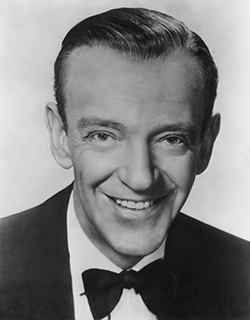Mr. Fred Astaire
Biography Of Mr. Fred Astaire


Astaire received an honorary Academy Award in 1950 for his “unique artistry and his contributions to the technique of musical pictures.” He holds choreography credits for ten of his movie musicals released between 1934-1961, including “Top Hat”, “Funny Face”, and “The Pleasure of His Company”. He won five Emmys for his work in television, including three for his variety shows, An Evening with Fred Astaire (1959, which won an unprecedented nine Emmys in all!) and Another Evening with Fred Astaire (1960).
In his later years, he continued to appear in movies, including “Finian’s Rainbow” (1968), and “The Towering Inferno” (1974) which earned him an Oscar nomination. He also starred in television roles on programs such as It Takes a Thief, and Battlestar Galactica (which he said he agreed to, due to the influence of his grandchildren). Astaire also lent his voice to several animated children’s TV specials, most notably, Santa Claus Is Comin’ to Town (1970), and The Easter Bunny is Comin’ to Town (1977). Astaire received a Lifetime Achievement Award in 1981 from the American Film Institute, who in 2011, also named him the “Fifth Greatest Actor” (among their “The 50 Greatest Screen Legends” list).
Fred Astaire died in 1987 from pneumonia, at the age of 88. With his passing, the world lost a true dancing legend. His effortless lightness and grace may never be seen again. As Mikhail Baryshnikov observed at the time of Fred Astaire’s death, “No dancer can watch Fred Astaire and not know that we all should have been in another business.”
Fred Astaire’s Dance Partners
Gracie Allen
1895 – 1964
Lucille Bremer
1917 – 1996
George Burns
1896 – 1996
Joan Caulfield
1922 – 1991
Barrie Chase
1933
Joan Crawford
1904 – 1977
Virginia Dale
1917 – 1994
Vera-Ellen
1921 – 1981
Joan Fontaine
1917 – 2013
Paulette Goddard
1910 – 1990
Audrey Hepburn
1929 – 1993
Betty Hutton
1921 – 2007
Gene Kelly
1912 – 1996
Ann Miller
1923 – 2004
Janis Paige
1922
Eleanor Powell
1912 – 1982
Marjorie Reynolds
1917 – 1997
Kay Thompson
1909 – 1998
Adele Astaire
1896 – 1981
Jack Buchanan
1891 -1957
Leslie Caron
1931
Cyd Charisse
1922 – 2008
Petula Clark
1932
Bing Crosby
1903 – 1977
LeRoy Daniels
1928 – 1993
Nanette Fabray
1920 – 2018
Judy Garland
1922 – 1969
Rita Hayworth
1918 – 1987
Harriet Hoctor
1905 – 1977
Olga San Juan
1927 – 2009
Claire Luce
1903 – 1989
George Murphy
1902 – 1992
Hermes Pan
1909 – 1990
Jane Powell
1929 – 2021
Ginger Rogers
1911 – 1995
“For ballroom dancing, remember that your partners have their own distinctive styles also. Cultivate flexibility. Be able to adapt your style to that of your partner. In doing so, you are not surrendering your individuality, but blending it with that of your partner.
– Fred Astaire, from The Fred Astaire Top Hat Dance Album (1936)
Fred Astaire Films & TV Specials
Flying Down to Rio
1933
The Gay Divorcee
1934
Roberta
1935
Top Hat
1935
Swing Time
1936
Follow the Fleet
1936
A Damsel in Distress
1937
Shall We Dance
1937
Carefree
1938
Second Chorus
1941
Holiday Inn
1942
The Sky's the Limit
1943
Blue Skies
1946
Ziegfeld Follies
1946
Easter Parade
1948
Three Little Words
1950
Let's Dance
1950
Royal Wedding
1951
The Band Wagon
1953
Daddy Long Legs
1955
Silk Stockings
1957
Funny Face
1957
On the Beach
1959
Finian's Rainbow
1968
It Takes a Thief
1998-1970
Midas Run
1969
The Towering Inferno
1975
Battlestar Galactica
1978-1979
Ghost Story
1981
Songs Introduced by Fred Astaire
Fred Astaire introduced many songs by famous American composers that became classics, including:
- Cole Porter’s “Night and Day” from The Gay Divorcee (1932)
- Jerome Kern’s “Nice Work If You Can Get It” from A Damsel In Distress (1937) and “A Fine Romance,” “The Way You Look Tonight,” and “Never Gonna Dance” from Swing Time (1936)
- Irving Berlin’s “Cheek To Cheek” and “Isn’t This A Lovely Day” from Top Hat (1936) and “Let’s Face The Music And Dance” from Follow The Fleet (1936)
- Gershwins’ “A Foggy Day” from A Damsel In Distress (1937) and “Let’s Call The Whole Thing Off,” “They All Laughed,” “They Can’t Take That Away From Me,” and “Shall We Dance” from Shall We Dance (1937)
